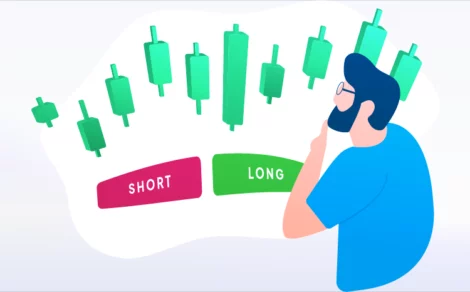A stop-loss order is used to automate a trade transaction. It helps protect investors from incurring losses by automatically executing trades when preset price levels are hit.
Toruscope » Online Trading » What is Stop Loss in Trading? Meaning, Types & Benefits
In stock trading, you don’t always have to monitor the market constantly to make buy or sell decisions. Just like you can automate bill payments through your bank with auto-pay, you can also automate your trades using pre-defined instructions called orders. One such essential tool for managing your trades is the stop-loss order.
In this article, we’ll explain stop-loss meaning, why it’s important, how it works, and how you can set up a stop-loss order effectively.
What Is Stop-Loss Trading?
A stop-loss order, also known as stop order, is when you set up an automated instruction to buy/sell a specific number of shares of a particular stock only when the actual stock price falls to a certain level, or what is called a ‘stop-price’. The stop price is decided by the investor, and the order will get triggered only when the stock price reaches the stop price. This helps investors manage risk effectively, especially when the market is volatile and price-sensitive.
How Does a Stop-Loss Order Work In Trading?
By setting the stop order, you can protect yourself from considerable losses in case the market moves against you. Here’s a step-by-step breakdown of how to set up a stop-loss order effectively:
Step 1: Evaluate Risk: To set up a stop order, it is important to evaluate your risk tolerance. While the aim is to earn profits and minimise losses, you need to know the extent to which you’re comfortable risking your investment. If a stock is priced at ₹100 per share, you need to decide up to what extent you are okay to incur a loss.
Step 2: Set the Limit Price: After evaluating your risk tolerance, you need to set the stop price for the stop order to be triggered. You decide on the percentage of risk you’re willing to take and set the price. For example, if the stock price is ₹100, and basis your understanding of the market trend, you’re willing to take a risk of up to 10%, then the ideal stop price could be ₹90.
Step 3: Select the Quantity and Expiry Date: Once you’ve set the trigger price, you enter the number of shares you wish to purchase at the pre-defined stock price along with the number of days you want the order to be active.
After setting up this order, there can be three possible scenarios.
Scenario 1: If the stock price increases, the order does not get triggered, so nothing happens.
Scenario 2: If the stock price stays the same, the order still does not get triggered.
Scenario 3: If the stock price reduces and is equal to or below the stop price, the order gets triggered and changes to a market order where the stocks are purchased as per the instructed amount (or nearest to the stock price) and quantity.
It is important to remember that a stop order doesn’t guarantee that the stock will be sold at the specified stop price. Once the stop order is triggered, it changes to a market order where the stocks can be bought/sold at the next available market price.
Types of Stop-Loss Order
Now that you know how stop-loss order works, let’s take a look at their two different types:
Fixed Stop-Loss Order
There can only be one trigger price for this type of stop order. When the actual stock price is equal to or below the stop price, the order gets triggered and changes to a market order and buys/sells shares immediately.
For example, assume that you want to purchase shares priced at ₹ 100 each. You have decided that you don’t wish to incur a loss of more than 10%. So, you fix your stop price at ₹ 90. Sometimes, you may feel that the stock price may take a longer time to reach the stop price. In such cases, while setting up a fixed stop-loss order, you can add a time limit. The order will stay active for the time duration you choose.
This makes the method straightforward and easier to execute, especially for investors who prefer a simple way to manage risks.
Trailing Stop-Loss Order
This is a flexible option where the trigger price changes as per the actual stock price. It aims at protecting profits and limiting potential losses. Unlike a fixed stop-loss order, it reduces the need to constantly monitor your investment.
To set up this order, first, you need to do the initial setup for a stop order. For example, assume that you want to purchase shares priced at ₹ 100 each. You have decided that you don’t wish to incur a loss of more than 10%. So, you set up a trailing stop-loss order at an initial stop price of ₹ 90 (10% below the actual stock price).
After setting up this order, there can only be three situations:
Situation 1: If the stock price increases to ₹ 110, the stop price will automatically change to 10% lower than the stock price, which is ₹ 100. The order will not be triggered.
Situation 2: If the stock price decreases to ₹ 90, the order will be triggered, and a market order will be executed.
Situation 3: If the stock price continues to increase to ₹ 130, the stop price will also continue to automatically change as per the initial set-up, i.e. 10% lower than the stock price, which is ₹ 117, until the order’s expiry date.
Benefits of Using a Stop-Loss Order
Here are a few reasons why a stop-loss order can enhance your trading experience:
- Managing risks: One of the unique characteristics of a stop order is that it helps you to define your risk tolerance in trading. The maximum loss you can make is limited to the percentage decrease you decide while fixing a stop price.
- Seamless execution: Owing to automation, setting up a stop order system manages the transactions without the need for regular monitoring.
- Less stressful: As an investor, it is very important not to get emotionally burned out because of market conditions. Setting up a stop order helps investors grow financially via responsible trading.
- Flexibility: Stop orders allow the investor to customise the trading experience by evaluating their risk tolerance and implementing preferred strategies.
- Reducing impulsive decisions: It is often noticed that critical market conditions can lead to poor decision-making. A stop order helps investors earn profits without running the risk of a huge loss.
Disadvantages of Stop-Loss Orders
Here are some common disadvantages of using stop-loss orders:
- Impact of market conditions: A price-sensitive or volatile market can go against the pre-decided stop order. Sometimes, it is difficult to understand the market trend and decide on a trading strategy, especially if the market is not predictable.
- Unforeseen fluctuations: If the market price of the stock moves in the opposite direction owing to sudden fluctuations in commerce, the stop order will eventually expire. Simultaneously, sudden short-term market fluctuations can trigger the stop order and result in a loss.
- Underselling stocks: The key issue with using a stop order is that it may sell/buy the stock at the wrong time and price. This might happen due to poor market understanding or unforeseen false fluctuations in the stock price.
- Execution costs: Sometimes, it gets expensive for investors to have brokers charge fees to execute stop orders.
- No guarantee of execution at the stop price: In highly volatile markets, the actual execution price may be worse than the stop price due to slippage.
Conclusion
While it’s important to leverage tools such as stop-loss orders to trade stocks efficiently, it’s important to remember that their primary purpose is to protect profits and manage risk, rather than to drive financial growth. The stop order is simply a tool to execute a strategy, not the strategy itself. Hence, one must always strike the right balance between technology and market knowledge.
To learn more about online trading, consider opening a free demat account with Torus Digital today!
Frequently Asked Questions
A major drawback is sensitivity to short-term volatility. Sudden price fluctuations may trigger the stop order prematurely, leading to unintended trades at unfavourable prices.
A stop order becomes a market order once the stop price is hit, while a limit order is executed only at the specified price or better. The former ensures execution, the latter ensures price.
Yes. Stop-loss orders can be triggered during market noise or extreme volatility, potentially locking in losses or missing out on rebounds that occur shortly after the trigger.
No. Stop-loss orders can be used for both intraday and delivery trades. Their primary purpose is risk management, regardless of trade duration.
Related Reads
What is Slippage in Trading? Meaning, Causes & Impact Explained
In trading, timing and precision often define success. However, even when a trader believes...
By: torus
- 7 mins
- 01.Jul.2025
- 4(1)
- 97
What is an Option Contract?
Imagine having the flexibility to buy or sell shares at a fixed price, no...
By: torus
- 7 mins
- 01.Jul.2025
- 0(0)
- 43
Types of Financial Instruments You Should Know Before Investing
Before investing funds in any market, it is essential to understand what financial instruments...
By: torus
- 7 mins
- 01.Jul.2025
- 0(0)
- 39
What are Contracts for Difference (CFD)?
Contracts for Difference, commonly known as CFDs, are financial instruments that allow traders to...
By: torus
- 9 mins
- 01.Jul.2025
- 0(0)
- 39
Difference between Short Position & Long Position
Understanding the concepts of short and long positions is essential for anyone interested in...
By: torus
- 8 mins
- 01.Jul.2025
- 0(0)
- 38
Essential Trading Terminologies You Need to Know
Trading in financial markets opens a world full of opportunities. For many first-time investors,...
By: torus
- 8 mins
- 01.Jul.2025
- 0(0)
- 47
Disclaimer: The content provided in this blog is for informational purposes only and does not constitute financial advice or recommendations. The content may be subject to change and revision. Readers are encouraged to conduct their own research and consult with a qualified financial advisor before making any investment decisions. Torus Digital and its affiliates takes no guarantees whatsoever as to its completeness, correctness or accuracy since these details may be acquired from third party and we will not be responsible for any direct or indirect losses or liabilities incurred from actions taken based on the information provided herein. For more details, please visit www.torusdigital.com.
Tenneco Clean Air IPO Listing: Strong Market Debut with 27% Premium
Tenneco Clean Air India Ltd made a confident entrance into the public markets on...
By: torus
- 5 mins
- 19.Nov.2025
-
3.7(6)
-
333
Stock to Buy Today: November 19, 2025
The Indian stock market witnessed a mild decline on November 18, 2025, ending a...
By: torus
- 4 mins
- 19.Nov.2025
-
4.3(3)
-
333
Mirae Asset Infrastructure Fund NFO: A Sector-Focused Bet on India’s Growth
Mirae Asset Mutual Fund has launched a new equity scheme — Mirae Asset Infrastructure...
By: torus
- 4 mins
- 18.Nov.2025
-
4.3(6)
-
333
Emmvee Photovoltaic IPO: Shares Make Muted Market Debut, List Flat At ₹217
Emmvee Photovoltaic Power made a muted debut on 18 November 2025, listing flat at...
By: torus
- 3 mins
- 18.Nov.2025
-
3.7(6)
-
333








